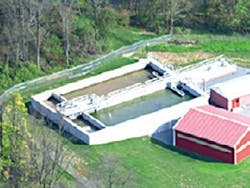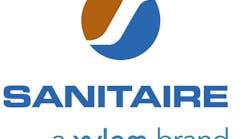The Newville Borough Water & Sewer Authority (NBWSA) has over 6.5 miles of sewers in the Borough serving a population of 1,326. An additional 5.7 miles of gravity sewers and one pumping station serves the surrounding municipalities.
Project Background
The Authority and its consulting engineer determined that to meet anticipated effluent criteria required by Pennsylvania Department of Environmental Protection (PA DEP), the existing wastewater treatment facility would be converted for aerobic sludge digestion and storage. Also, a new wastewater treatment facility would be constructed to meet the future organic and hydraulic capacity needs of the Authority and the Chesapeake Bay watershed nutrient loading limits proposed for existing wastewater treatment discharges.
The plant had to meet future capacity needs and Chesapeake Bay Strategy nutrient loading limits.
Solution
The new facility consists of two Sanitaire ICEAS continuous fill SBR tanks preceded by an automatically operated fine screen to remove trash and inorganic solids.
As a safety feature, there is no floating equipment within the SBR basins. All equipment is mounted to the tank walls and can be maintained without entering the basin. The tanks’ fine bubble diffuser grids are mounted to the basin floor, but unlike a true batch SBR system, the ICEAS process can operate using a single basin without process modifications or effluent degradation. This allows a basin to be drained for maintenance, if necessary.
The new facility is equipped with mechanical mixers, in-tank dissolved oxygen sensors and VFD-controlled blowers so that aeration can be controlled by the dissolved oxygen concentration in the basins during the react period of the treatment cycle. This prevents over-aeration during aeration periods of the react cycle, allowing the dissolved oxygen to quickly crash during anoxic periods in the cycle. Alternating periods of oxic react and anoxic react generate nitrate and denitrify the nitrate created, respectively. Nitrogen gas produced by denitrification is stripped during a final aeration period prior to settling.
In addition to a superior effluent, the new facility has experienced operational savings.
Result
A 20-25% reduction in electric costs was realized almost immediately after start-up due to the DO concentration control system and the recovery of oxygen from the denitrification process. Another advantage of the process is its operator friendliness. With no return or recycle pumping to adjust, the only typical adjustment required is the waste sludge wasting rate, in order to maintain the target MLSS concentration.
Having the ability to treat total nitrogen below permit limits not only reduces energy costs by taking advantage of demand-only aeration and denitrification oxygen release, it can also generate a new revenue stream in the form of nutrient credit trading. Unused nutrient allocations can be sold to other facilities that cannot meet their allocation.
Editor's Note: Scranton Gillette Communications and the SGC Water Group are not liable for the accuracy, efficacy and validity of the claims made in this piece. The views expressed in this content do not reflect the position of the editorial teams of Water & Wastes Digest, Water Quality Products and Storm Water Solutions.



